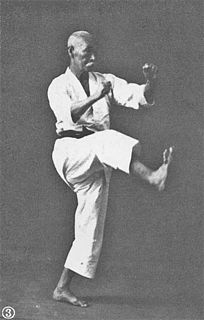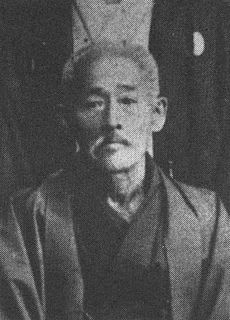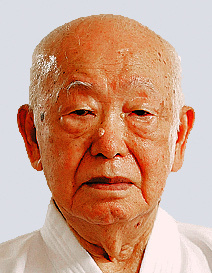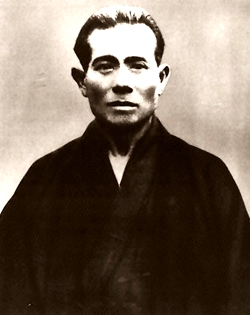 W
WAnkichi Arakaki born in 1899 in Shuri Okinawa became an Okinawan martial arts master who, despite dying at the age of 28 in 1927, is notable for aiding in the evolution of Shōrin-ryū karate. He was extremely important in the education of Shōshin Nagamine, who later went on to found Matsubayashi-ryū karate. He was also the uncle of Ansei Ueshiro, the chief instructor at Shoshin Nagamine's original dojo and creator of Fukyugata Sandan.
 W
WKiyoshi Arakaki is a karate practitioner, historian, novelist and the founder of Okinawa Karate-Do Muso-Kai, as well as an author of over 11 books.
 W
WArakaki Seishō was a prominent Okinawan martial arts master who influenced the development of several major karate styles. He was known by many other names, including Aragaki Tsuji Pechin Seisho.
 W
WChōshin Chibana was an Okinawan martial artist who developed Shorin-ryū karate based on what he had learned from Ankō Itosu. He was the last of the pre-World War karate masters, also called the "Last Warrior of Shuri" He was the first to establish a Japanese ryu name for an Okinawan karate style, calling Itosu's karate "Shorin-Ryu" in 1928.
 W
WYoshimura Chōgi was a karate master of Okinawa.
 W
WGichin Funakoshi was the founder of Shotokan karate-do, perhaps the most widely known style of karate, and is known as a "father of modern karate". Following the teachings of Anko Itosu and Anko Asato, he was one of the Okinawan karate masters who introduced karate to the Japanese mainland in 1922, following its earlier introduction by his teacher Itosu. He taught karate at various Japanese universities and became honorary head of the Japan Karate Association upon its establishment in 1949.
 W
WGigō Funakoshi was the third son of Gichin Funakoshi and is widely credited with developing the foundation of the modern karate Shotokan style.
 W
WShinpan Gusukuma , read as Shinpan Shiroma in standard Japanese, was an Okinawan martial artist who studied Shōrin-ryū karate as a student of Ankō Itosu. Gusukuma also trained under Higaonna Kanryō in the Naha-te style. Gusukuma went on to establish Shitō-ryū with Kenwa Mabuni.
 W
WChōmo Hanashiro was an Okinawan martial arts master who is notable for aiding in the evolution of Shōrin-ryū karate. Early in his childhood, he became a student of the renowned master Matsumura Sōkon, of the Shuri-te style. In addition to being a recognized expert in martial arts, Chomo was the first to formally use the kanji kara (空) instead of "to" or "tang" (唐), a term by which Okinawa's martial art became known: "karate".
 W
WSekō (Seiko) Higa was a Gojū Ryū karate teacher who was born in Naha.
 W
WHigashionna Kanryō , also known as Higashionna West, was a Ryukyuan martial artist who founded a fighting style known at the time as Naha-te. He is recognized as one of the first students of Fujian White Crane Kung Fu masters, namely Ryū Ryū Ko, in the Fuzhou region of China who returned with those skills to Okinawa. His student, Chōjun Miyagi, would later found Gōjū ryū Karate.
 W
WMorio Higaonna is a prominent Okinawan karate practitioner who is the founder and former Chief Instructor of the International Okinawan Goju-ryu Karate-do Federation (IOGKF). He is a holder of the highest rank in Goju-ryu karate, 10th dan. Higaonna has written several books on Goju-ryu karate, including Traditional Karate-do: Okinawa Goju Ryu (1985) and The history of Karate: Okinawan Goju Ryu (2001). Martial arts scholar Donn Draeger (1922–1982) reportedly once described him as "the most dangerous man in Japan in a real fight."
 W
WMasayoshi Kori Hisataka was the founder of Shorinjiryu Kenkokan Karate.
 W
WAnkō Itosu is considered by many the father of modern karate. This title is also often given to Gichin Funakoshi because of the latter spreading karate throughout Japan, but only after Ankō sensei had introduced the art of Okinawate to the country.
 W
WKanki Izumigawa was a karate master who learned Goju-Ryu from Seiko Higa on Okinawa and Saipan. Higa had studied under Kanryo Higashionna and trained with Chojun Miyagi. In his youth Izumigawa also studied karate under Juhatsu Kyoda, who was himself a senior student of Kanryo Higashionna. Izumigawa was born in Okinawa to a samurai family and was the founder of the Senbukan Dojo, which had its headquarters in Kawasaki City and branches in Tokyo, Osaka, Ota, Yokoyama, Nagoya and even Hawaii. The Senbukan dojo was established in 1939 and was the first dojo of Okinawan Goju-Ryu on mainland Japan. Today, It's currently the oldest Goju-Ryu dojo in the world.
 W
WChokei Kishaba was an Okinawan martial arts master and founder of the Shōrin-ryū Kishaba Juku.
 W
WChotoku Kyan was an Okinawan karate master who was famous for both his karate skills and his colorful personal life. He had a large influence on the styles of karate that would become Shorin-Ryu and its related styles.
 W
WKenwa Mabuni was one of the first karateka to teach karate in mainland Japan and is credited as developing the style known as Shitō-ryū. Originally, he chose the name Hanko-ryu, literally "half-hard style", to imply that the style used both hard and soft techniques. Finally, Mabuni chose Shito-ryu, the first characters of the names Itosu and Higaonna, his two primary teachers.
 W
WMatsumura Sōkon was one of the original karate masters of Okinawa. The years of his lifespan are reported variously as c.1809-1901 or 1798–1890 or 1809–1896 or 1800–1892. However, the dates on the plaque at Matsumura's tomb, put there by Matsumura's family, clearly state that he was born in 1809 and died in 1899.
 W
WChōjun Miyagi was an Okinawan martial artist who founded the Gōjū-ryū school of karate by blending Okinawan and Chinese influences.
 W
WMotobu Chōki was an Okinawan karateka from Akahira Village in Shuri, Okinawa, capital of the Ryūkyū Kingdom when he was born. His older brother Motobu Chōyū was also a noted karateka.
 W
WShōshin Nagamine was a Okinawa karate master as well as a soldier, police superintendent, mayor of Naha City, play director and author.
 W
WSeigi Nakamura (1924-1999) was an Okinawan martial arts master who learned both the Shōrin-ryū and Gōjū-ryū styles of karate.
 W
WShūgorō Nakazato was an Okinawan martial artist. Described as a "one punch artist" by some of his American students, Nakazato developed his karate sparring into "a fine fighting art". He gave many demonstrations in Japan as well as abroad and had "many well-known students in the USA", Nakazato was designated as an "intangible cultural asset holder" by Okinawa Prefecture in 2000. He was awarded the Order of the Rising Sun, 5th Class with Gold and Silver Rays on November 4, 2007.
 W
WKosei Nishihira was an Okinawan martial arts master of Shōrin-ryū Matsumura Seitō Karate and Kobudō.
 W
WKanga Sakugawa , also Sakugawa Satunushi and Tode Sakugawa, was a Ryūkyūan martial arts master and major contributor to the development of Te, the precursor to modern Karate.
 W
WHohan Sōken was an Okinawan martial arts master who founded the Shōrin-ryū Matsumura Seito Okinawa Karate Kobudo Association.
 W
WMasaji Taira is a leading teacher of Okinawa Goju Ryu Karate Do, and head of the Okinawa Gojuryu Kenkyu Kai. His teacher was Eiichi Miyazato, a student of Chojun Miyagi and the founder of the Okinawan Jundokan dojo. Taira's karate is that of his teacher and the Jundokan, with the addition of his novel approach to the application of the kata.
 W
WKanken Tōyama was a Japanese schoolteacher and karate master, who developed the foundation for the Shūdōkan karate style.
 W
WKanbun Uechi was the founder of Uechi-Ryū, one of the primary karate styles of Okinawa.
 W
WKanei Uechi was the son of Kanbun Uechi, founder of Uechi-Ryū, one of the primary karate styles of Okinawa. Kanei was instrumental and at the forefront of Uechi-Ryū's growth after his father's death.